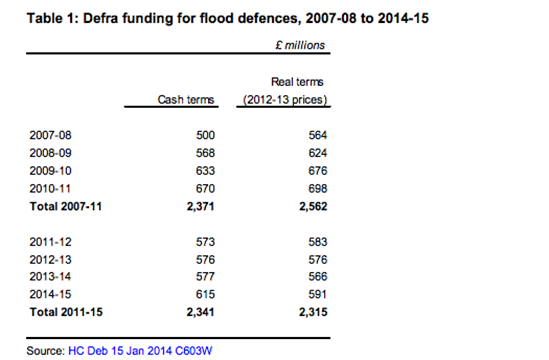Robin Webster
27.02.2014 | 10:00amIn 1953, more than 300 people lost their lives and 24,000 homes were damaged or destroyed in one night of flooding. In 2014, the wettest winter on record put 6,000 properties under water – but new flood defences protected hundreds of thousands more. Experts are worried the defences won’t be as effective in the future, however.
Government spend on flood defences “provide neither the level of investment or long-term certainty” to guarantee the country’s resilience against future flood events, argues the Institute of Civil Engineers. The organisation has added its voice to growing calls for the government to beef up its plans – and budget – for protecting the country from rising sea levels and more intense rainfall.
But despite the criticism, the government claims it’s spending “more than ever before” on flood defences.
How flooding spending has changed
Between 1997 and 2010, government spend on flood defences increased by about three quarters in real terms, according to a recent analysis by the House of Commons Library.
But after the 2010 election, the new coalition government introduced spending cuts. The most recent data – released by Defra in response to a parliamentary question in January – shows Defra spent £2.56 billion on flooding defences between 2007 and 2011. Between 2011 and 2015, it plans to spend slightly less – £2.3 billion in real terms.
The table below shows how the funding breaks down on a per year basis:
Different sorts of flooding spend
The government continues to argue that it’s spending “more than ever before” on flood spending, however. That’s because it includes different sources in its analysis – which others don’t.
In the graph below, produced by the Committee on Climate Change (CCC), government spend breaks down into capital expenditure on flood defences (coloured blue) and revenue expenditure on day to day maintenance of the flood defence system (coloured red).
An extra £120 million of funding for flood defences, announced by George Osborne in 2012, is coloured green.
But the government’s figures also include money from ‘external contributions’, coloured purple. This refers to money – amounting to £129 million – that the government has given to local authorities for work on flood defences.
 Source: Committee on Climate Change analysis, February 2014. The graph shows government spend on flood and coastal erosion risk management spending (FCERM), delivered via Defra, the Environment Agency and Local Authorities.
Source: Committee on Climate Change analysis, February 2014. The graph shows government spend on flood and coastal erosion risk management spending (FCERM), delivered via Defra, the Environment Agency and Local Authorities.
But it’s problematic to count this extra cash to local authorities, the CCC says, because the money given to authorities isn’t ringfenced, meaning they can spend it on other things. Indeed, the evidence suggests that authorities aren’t spending all the money on flood defences.
The government also assumes that some money will come from the private sector – for example from developers or landowners who want to protect their property. Last year, Parliament’s Environment, Food and Rural Affairs committee expressed concern at the ” small amounts” of private sector funding that had been committed under the programme. In 2012, the Guardian suggested the scheme had attracted just £2.6m of private sector funding in two years.
In a letter to Labour MP Hugh Bayley,
covered yesterday by the Guardian, the head of the UK statistics authority Sir Andrew Dilnot says its analysis of the figures agrees that once the contributions from LAs are excluded from the calculation, the government is spending less on flood defences in 2011-15 than in did in 2007-11.
Climate change – spend needs to go up, not down
Organisations are concerned about the future of flooding spending, too. According to the CCC, the government’s spending plans amount to no real increase in funding between 2015 and up to 2021.
This worries the CCC because climate change is predicted to raise the risk of flooding through heavier rainfall and sea level rise. The Environment Agency’s most recent report suggests it will need £20 million year on year increase in flood defence funding to respond to the challenge.
The CCC says the government’s funding plans mean that by the beginning of the next Parliament, flood defence funding will be falling short by £180 million a year.
Spend money to save money
The government may be trying to save money – but an increasing number of organisations are concerned that skimping on flood defences could end up costing the country a lot more. Every £1 invested in flood defences prevents £8 in future damages, according to the CCC. And without spend now, it says the country can expect an extra £3 billion in avoidable flood damage in future years.
Following David Cameron’s announcement that ” money is no object” on flood defence, government has pledged £130m in cleanup money from the floods. The money will only go towards repairing damaged flood defences, however, rather than creating any new ones.
More flooding in the future could end up costing a lot more in cleanup money – leaving the government and Environment Agency playing catchup and with less and less chance to prepare for the challenges to come. That would probably be a false economy.


